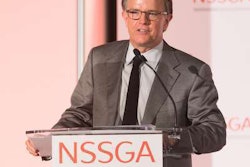
Members of the Silica/Asphalt Milling Machine Partnership recognized the culmination of the group’s 10-year effort to improve worker safety with a ceremony during the World of Asphalt in Baltimore and releases of a best practices guide and a field guide.
The partnership is made up of the National Asphalt Pavement Association (NAPA), the National Institute for Occupational Safety and Health (NIOSH), milling-machine manufacturers, and other industry and academia members. The group has been working since 2005 to “design, test, and implement engineering controls for milling machines that effectively reduce potential silica exposure below Occupational Safety and Health Administration’s (OSHA) new proposed permissible exposure limit (PEL).”
“Some 1.7 million U.S. workers are exposed to respirable crystalline silica in a variety of occupations, including road and highway workers,” said Dr. Christine Branche, director of the Office of Construction Safety and Health at NIOSH. “It is incurable, but completely preventable.”
Branche touted the recent NIOSH release of the “Best Practice Engineering Control Guidelines to Control Worker Exposure to Respirable Crystalline Silica during Asphalt Pavement Milling” best practices document. It can be downloaded at here.
“Some 1.7 million U.S. workers are exposed to respirable crystalline silica in a variety of occupations, including road and highway workers,” Branche said. “It is incurable, but completely preventable.”
NAPA and the Center for Construction Research and Training also announced the release of their “Field Guide for Controlling Silica Dust Exposure on Asphalt Paving Milling Machines,” which is available here.
“Thanks to this constructive partnership between industry, equipment manufacturers, labor, and regulators, engineering controls that ensure worker protection during roadway milling operations will soon be standard equipment on milling machines,” said NAPA President Mike Acott. “It shows the sort of progress that can be made when government, labor, and industry work together, in a voluntary fashion, to address real-world issues.”









